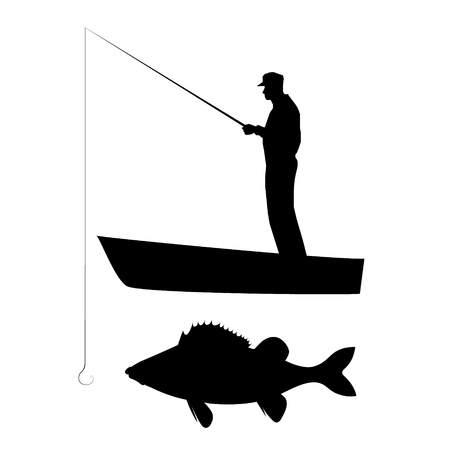1. Understanding the Basics of Fishing Line
Fishing line might seem like a simple piece of gear, but it plays a huge role in whether you land that trophy bass or watch it swim away. Choosing the right fishing line can affect how your bait moves, how well fish see it, and even how much pressure it can handle before snapping. Let’s break down the core characteristics that define a fishing line so you can get a feel for what works best in different situations.
Key Characteristics of Fishing Line
There are four main features to consider when picking a fishing line: strength, stretch, visibility, and abrasion resistance. Each type of line—monofilament, fluorocarbon, and braided—has its own mix of these traits. Here’s what each characteristic means:
Strength
This refers to the line’s ability to handle weight and pressure without breaking. It’s usually measured in pounds (called “pound test”). If you’re going after big fish like pike or catfish, you’ll want a stronger line than if youre targeting panfish like bluegill.
Stretch
Some lines stretch more than others. Stretchy lines like monofilament can absorb shock better, which is helpful when a fish makes a sudden run. Less stretchy lines like braid offer more sensitivity so you can feel every nibble.
Visibility
This is all about how easy it is for fish to see your line underwater. In clear water or when targeting finicky fish, you’ll want a low-visibility line like fluorocarbon. In murky water or heavy cover, visibility might not matter as much.
Abrasion Resistance
If you’re fishing around rocks, logs, docks, or other rough surfaces, your line needs to hold up against wear and tear. Some lines are tougher than others when it comes to scraping and rubbing against obstacles.
Comparison Table: Core Fishing Line Traits
| Line Type | Strength | Stretch | Visibility | Abrasion Resistance |
|---|---|---|---|---|
| Monofilament | Moderate | High | Moderate (more visible) | Good |
| Fluorocarbon | High | Low to Moderate | Low (nearly invisible) | Excellent |
| Braided | Very High | Very Low | High (easily seen) | Very Good |
Understanding these basic features helps you make smarter decisions on the water. Whether youre casting from shore or trolling from a boat, matching your fishing line to your target species and environment makes all the difference.
2. Monofilament Line: Trusted All-Around Performer
Monofilament fishing line, often simply called “mono,” is one of the most popular and widely used types of fishing line in the United States. Its been a go-to option for generations of anglers, from weekend warriors to seasoned pros. Known for its affordability, ease of use, and versatility, monofilament is often the first line new anglers try—and many stick with it for years.
What is Monofilament Line?
Monofilament line is made from a single strand of nylon or similar synthetic material. It’s flexible, smooth, and stretches under pressure, which can be helpful when fighting fish as it reduces the chances of the hook pulling out. Mono also floats better than other types of lines, making it a solid choice for topwater lures and light tackle setups.
Pros and Cons of Monofilament Line
| Pros | Cons |
|---|---|
| Budget-friendly and widely available | Stretches more than other lines (can reduce sensitivity) |
| Easy to tie knots with | UV rays and water absorption can weaken it over time |
| Versatile for many fishing techniques | Less abrasion-resistant compared to fluorocarbon or braid |
| Good shock absorption for fighting fish | Tends to have more line memory (can cause tangles and coils) |
When to Use Monofilament
If youre fishing in freshwater lakes for bass, crappie, bluegill, or trout, monofilament is a great all-around choice. Its especially effective when using topwater baits since it floats naturally. Mono is also ideal when you need some stretch in your line—for example, when trolling or using live bait where a sudden strike could break a stiffer line.
Best Situations for Monofilament:
- Topwater Fishing: Its buoyancy helps keep lures on the surface.
- Beginner-Friendly: Easy to handle and forgiving during casting and retrieval.
- Bait Fishing: The stretchiness helps prevent hook pull-outs when fish strike.
Pro Tip:
If youre spooling up a spinning reel for casual freshwater fishing, starting with monofilament is a smart move. Look for a line strength (test) that matches your target species—6-10 lb test works well for most panfish and bass setups.
While monofilament may not have the high-tech edge of fluorocarbon or braided lines, its reliability and user-friendliness make it a staple in many tackle boxes across America.

3. Fluorocarbon Line: Invisibility and Sensitivity
Fluorocarbon fishing line is a favorite among anglers who need stealth and precision. Known for its near-invisible appearance underwater, fluorocarbon is ideal when fishing in clear water where fish are easily spooked. Its also highly sensitive, making it perfect for finesse techniques that require you to feel even the lightest bites.
What Makes Fluorocarbon Special?
The biggest advantage of fluorocarbon is how it behaves in water. Its refractive index is close to that of water, which means it becomes almost invisible to fish. This gives you a major edge in situations where fish are line-shy or when the water is crystal clear.
Key Benefits of Fluorocarbon Line:
| Feature | Benefit |
|---|---|
| Low Visibility | Almost invisible underwater—perfect for clear water fishing |
| High Sensitivity | Transmits subtle bites and bottom contact better than mono |
| Abrasion Resistance | Great around rocks, docks, and heavy cover |
| Sinks Naturally | Helps keep baits in the strike zone longer |
Best Situations to Use Fluorocarbon
If youre fishing in gin-clear lakes or pressured waters, fluorocarbon is your best friend. Its also the go-to choice for finesse rigs like drop shots, Ned rigs, or shaky heads—techniques where sensitivity and stealth matter most.
Popular Techniques That Benefit from Fluorocarbon:
- Drop Shotting: Feel soft bites with maximum sensitivity.
- Ned Rig: Maintain a natural presentation without spooking fish.
- Texas Rig: Good abrasion resistance for dragging through cover.
- Crankbaits (as leader): Sinking quality helps get lures deeper faster.
Pro Tip:
If youre worried about cost, use fluorocarbon as a leader with braided main line. You’ll get the best of both worlds—strength from braid and invisibility from fluoro—without breaking the bank.
Whether youre targeting bass in pressured lakes or trout in mountain streams, fluorocarbon gives you the confidence that your line isn’t giving you away. Its a smart pick when finesse and subtlety are key to getting bites.
4. Braided Line: Strength and Sensitivity Combined
When it comes to fishing lines that pack a punch in both strength and performance, braided line stands out as a top choice for many American anglers. Known for its ultra-thin diameter, impressive durability, and zero stretch, braid is perfect for situations where power and sensitivity are key.
What Makes Braided Line Special?
Braided fishing line is made by weaving together multiple strands of synthetic fibers like Spectra or Dyneema. This process creates a super-strong line with several standout features:
- High Strength-to-Diameter Ratio: Braid offers superior strength while maintaining an incredibly thin profile. This means you can spool more line onto your reel without sacrificing power.
- Sensitivity: Because it has virtually no stretch, youll feel even the lightest bites. This makes it ideal for detecting subtle movements, especially in deep water or when jigging.
- Long Casting Distance: The thin diameter helps reduce drag on your guides, allowing you to cast farther than with monofilament or fluorocarbon.
Best Use Cases for Braided Line
Braided line shines in specific fishing scenarios. Heres a breakdown of when and where to use it:
| Fishing Scenario | Why Braid Works Best |
|---|---|
| Heavy Cover (lily pads, thick vegetation) | Braid cuts through weeds and resists abrasion from structure. |
| Saltwater Fishing | The durability and long casting ability make it great for surf and offshore fishing. |
| Bottom Fishing & Deep Dropping | No-stretch property transmits bites from deep water directly to your rod tip. |
| Trolling | The thin diameter reduces resistance and lets lures dive deeper. |
Tackle Tips for Using Braid
- Knot Choice: Use knots designed for braid like the Palomar or Double Uni Knot to prevent slippage.
- Add a Leader: Since braid is visible in clear water, consider tying on a fluorocarbon leader to stay stealthy.
- Avoid Line Digging: On baitcasting reels, maintain steady tension during retrieval to prevent the braid from digging into itself on the spool.
Braid Quick Facts
| Braided Line Characteristic | Description |
|---|---|
| Main Material | Spectra or Dyneema fibers |
| Stretch Level | No stretch (extremely sensitive) |
| Abrasion Resistance | Moderate (best with proper handling) |
| Knot Strength | A bit tricky—requires specific knots |
If youre looking for ultimate control, long casts, and the ability to fight big fish through tough cover, braided line could be your new best friend on the water. Understanding how and when to use it will help you get the most out of every cast.
5. Choosing the Right Line for Your Fishing Style
Picking the right fishing line can make a huge difference in your success on the water. Whether youre casting for largemouth bass in a quiet lake or trolling offshore for tuna, the type of line you choose should match your technique, target species, and fishing environment.
Match Your Line to Your Fishing Technique
Different techniques call for different line characteristics. Here’s a quick breakdown:
| Fishing Technique | Recommended Line Type | Why It Works |
|---|---|---|
| Bass Fishing (Casting/Spinning) | Fluorocarbon or Braided with Fluoro Leader | Low visibility and good sensitivity help detect light bites |
| Trolling Offshore | Braided Mainline with Mono Leader | Braid offers strength and capacity; mono leader provides stretch and shock absorption |
| Panfish or Trout in Clear Water | Monofilament or Fluorocarbon | Softer presentation and low visibility are key in clear water |
| Topwater Lures | Monofilament | Floating properties keep lures on the surface effectively |
| Jigging Deep Water | Braided Line | No-stretch design increases sensitivity and hook sets at depth |
Consider Your Target Species
The size and behavior of your target fish affect your line choice. For example, toothy fish like pike may require a stronger or abrasion-resistant leader, while finesse species like crappie benefit from thin-diameter monofilament or fluorocarbon lines.
Common Species and Line Suggestions:
| Species | Suggested Line Type |
|---|---|
| Largemouth Bass | Braid with Fluoro Leader or Straight Fluorocarbon (15–20 lb test) |
| Trout | Light Monofilament or Fluorocarbon (2–6 lb test) |
| Pike/Muskie | Braided Line with Wire or Heavy Fluoro Leader (50–80 lb test) |
| Redfish/Snook (Inshore Saltwater) | Braid with Fluorocarbon Leader (20–30 lb test) |
| Tuna/Mahi-Mahi (Offshore) | Braided Mainline with Mono Topshot or Fluoro Leader (50–100 lb test) |
Factor In the Environment
Freshwater vs Saltwater:
- Freshwater: All three types of line work well depending on clarity and cover. Monofilament is great for beginners, while fluoro is ideal for clear lakes.
- Saltwater: Braid is often preferred for its strength-to-diameter ratio and durability against salt corrosion. Always pair it with a suitable leader.
Casting Distance & Sensitivity:
- Braid: Best for long casts and high sensitivity.
- Fluorocarbon: Great for stealthy presentations where fish are line-shy.
- Monofilament: Offers forgiveness due to stretch but may sacrifice sensitivity.
No matter where or what youre fishing for, choosing the right line helps maximize performance. Keep your technique, target species, and environment in mind to make the best choice every time you hit the water.


